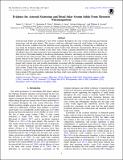Evidence for Asteroid Scattering and Distal Solar System Solids From Meteorite Paleomagnetism
Author(s)
Bryson, James F. J.; Weiss, Benjamin P.; Lima, Eduardo A.; Gattacceca, Jérôme; Cassata, William S.
DownloadPublished version (1.689Mb)
Publisher Policy
Publisher Policy
Article is made available in accordance with the publisher's policy and may be subject to US copyright law. Please refer to the publisher's site for terms of use.
Terms of use
Metadata
Show full item recordAbstract
Asteroid-sized bodies are predicted to have been scattered throughout the solar system following gravitational interactions with the giant planets. This process could have delivered water-rich small bodies to the inner solar system. However, evidence from the meteorite record supporting this scattering is limited due to difficulties in recovering the formation distance of meteorite parent bodies from laboratory measurements. Moreover, ancient millimeter-sized solids that formed in the inner solar system (calcium–aluminum-rich inclusions (CAIs) and chondrules) have also been proposed to have migrated throughout the solar system, which could have been key to their survival. Our understanding of the driving mechanisms, distances, and timings involved in this motion is also restricted for the same reasons. Here, we address these limitations by recovering the formation distance of the parent asteroid of the Tagish Lake meteorite from measurements of its natural remanent magnetization. We find that this meteorite experienced an ancient field intensity <0.15 μT. Accounting for the average effect of a tilted parent body rotation axis and possible uncertainties associated with the remanence acquisition mechanism, this result argues that the Tagish Lake parent body formed at >8–13 au, suggesting this body originates from the distal solar system. Tagish Lake came to Earth from the asteroid belt which, combined with our recovered formation distance, suggests that some small bodies traveled large distances throughout the solar system. Moreover, Tagish Lake contains CAIs and chondrules, indicating that these solids were capable of traveling to the distal solar system within just a few million years.
Date issued
2020-04Department
Massachusetts Institute of Technology. Department of Earth, Atmospheric, and Planetary SciencesJournal
Astrophysical Journal
Publisher
American Astronomical Society
Citation
Bryson, James F. J. et. al., "Evidence for Asteroid Scattering and Distal Solar System Solids From Meteorite Paleomagnetism." Astrophysical Journal 892, 2 (April 2020): no.126 doi. 10.3847/1538-4357/ab7cd4 ©2020 Authors
Version: Final published version
ISSN
0004-637X